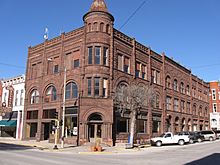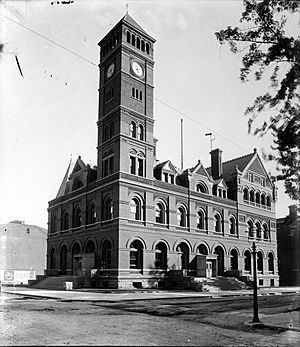Lee County, Iowa facts for kids
Quick facts for kids
Lee County
|
|
|---|---|
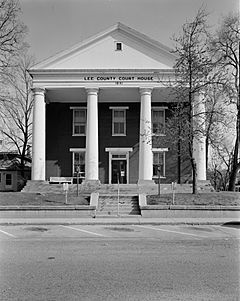
Courthouse located in Fort Madison
|
|
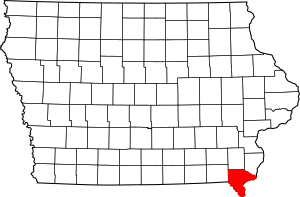
Location within the U.S. state of Iowa
|
|
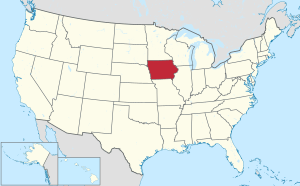 Iowa's location within the U.S. |
|
| Country | |
| State | |
| Founded | 1836 |
| Seat | Fort Madison and Keokuk |
| Largest city | Fort Madison |
| Area | |
| • Total | 539 sq mi (1,400 km2) |
| • Land | 518 sq mi (1,340 km2) |
| • Water | 21 sq mi (50 km2) 4.0% |
| Population
(2020)
|
|
| • Total | 33,555 |
| • Density | 62.25/sq mi (24.036/km2) |
| Time zone | UTC−6 (Central) |
| • Summer (DST) | UTC−5 (CDT) |
| Congressional district | 2nd |
Lee County is the southernmost county in the U.S. state of Iowa. As of the 2020 census, the population was 33,555. The county seats are Fort Madison and Keokuk.
Lee County is part of the Fort Madison–Keokuk, IA-IL-MO Micropolitan Statistical Area.
Contents
History
Fort Madison dates to the War of 1812. Lee County was the location of the Half-Breed Tract, established by treaty in 1824. Allocations of land were made to American Indian descendants of European fathers and Indian mothers at this tract. Originally the land was to be held in common. Some who had an allocation lived in cities, where they hoped to make better livings.
Lee County as a named entity was formed on December 7, 1836, under the jurisdiction of Wisconsin Territory. It would become a part of Iowa Territory when it was formed on July 4, 1838. Large-scale European-American settlement in the area began in 1839, after Congress allowed owners to sell land individually. Members of the Church of Christ (Latter Day Saints) fled persecutions in Missouri to settle in Illinois and Iowa. Nauvoo, across the border in Hancock County, Illinois, became the main center of Latter-day Saints settlement, but there was also a Latter Day Saints stake organized in Lee County under the direction of John Smith, the uncle of Joseph Smith, land that was sold to them by Isaac Galland in 1839.
Lee has two county seats — Fort Madison and Keokuk. The latter was established in 1847 when disagreements led to a second court jurisdiction.
Lee County's population grew to about 19,000 in 1850, the first US census, to 37,000 per the 3rd census in 1870, peaking at 44,000 people in 1960. It has continuously decreased since and as of 2010, 35,862 people lived there, comparable to the years between 1860-1870.
Name
There is no agreement about the derivation of the name "Lee." It has been variously proposed that the county was named for Marsh, Delevan & Lee, of Albany, New York, and the 'New York Land Company', who owned extensive interests in the Half-Breed Tract in the 1830s; Robert E. Lee, who surveyed the Des Moines Rapids; or Albert Lea, who helped explore the interior of Iowa.
Geography
According to the U.S. Census Bureau, the county has a total area of 539 square miles (1,400 km2), of which 518 square miles (1,340 km2) is land and 21 square miles (54 km2) (4.0%) is water. The lowest point in the state of Iowa is located on the Mississippi River in Keokuk in Lee County, where it flows out of Iowa and into Missouri and Illinois.
Major highways
Adjacent counties
Lee County is surrounded by Henry County to the north, Des Moines County to the northeast, Henderson County, Illinois, across the river east, Hancock County, Illinois to the southeast, Clark County, Missouri in the southwest and Van Buren County, Iowa in the west.
Demographics
| Historical population | |||
|---|---|---|---|
| Census | Pop. | %± | |
| 1850 | 18,861 | — | |
| 1860 | 29,565 | 56.8% | |
| 1870 | 37,210 | 25.9% | |
| 1880 | 34,859 | −6.3% | |
| 1890 | 37,715 | 8.2% | |
| 1900 | 39,719 | 5.3% | |
| 1910 | 36,702 | −7.6% | |
| 1920 | 39,676 | 8.1% | |
| 1930 | 41,268 | 4.0% | |
| 1940 | 41,074 | −0.5% | |
| 1950 | 43,102 | 4.9% | |
| 1960 | 44,207 | 2.6% | |
| 1970 | 42,996 | −2.7% | |
| 1980 | 43,106 | 0.3% | |
| 1990 | 38,687 | −10.3% | |
| 2000 | 38,052 | −1.6% | |
| 2010 | 35,862 | −5.8% | |
| 2020 | 33,555 | −6.4% | |
| U.S. Decennial Census 1790-1960 1900-1990 1990-2000 2010-2018 |
|||
2020 census
The 2020 census recorded a population of 33,555 in the county, with a population density of 62.0765/sq mi (23.9679/km2). 94.67% of the population reported being of one race. 87.10% were non-Hispanic White, 2.71% were Black, 3.31% were Hispanic, 0.21% were Native American, 0.42% were Asian, 0.02% were Native Hawaiian or Pacific Islander and 6.23% were some other race or more than one race. There were 15,858 housing units, of which 14,036 were occupied.
2010 census
The 2010 census recorded a population of 35,862 with a population density of 69.3133/sq mi (26.7620/km2). There were 16,205 housing units, of which only 14,610 were occupied.
Communities
Cities
Census-designated place
Other unincorporated communities
- Argyle
- Marion
- New Boston
- Pilot Grove
- Wever
Townships
- Cedar
- Charleston
- Denmark
- Des Moines
- Franklin
- Green Bay
- Harrison
- Jackson
- Jefferson
- Madison
- Marion
- Montrose
- Pleasant Ridge
- Van Buren
- Washington
- West Point
Population ranking
The population ranking of the following table is based on the 2010 census of Lee County.
† county seat
| Rank | City/Town/etc. | Municipal type | Population (2010 Census) |
|---|---|---|---|
| 1 | † Fort Madison | City | 11,051 |
| 2 | † Keokuk | City | 10,780 |
| 3 | West Point | City | 966 |
| 4 | Donnellson | City | 912 |
| 5 | Montrose | City | 898 |
| 6 | Denmark | CDP | 423 |
| 7 | Houghton | City | 146 |
| 8 | Franklin | City | 143 |
| 9 | St. Paul | City | 129 |
Notable people
- Cleng Peerson (1783–1865), pioneer settler in Lee County in 1840
- Richard Proenneke (1916–2003), naturalist, subject of books and documentary
- William Elliott Whitmore (born 1978), singer and songwriter
Images for kids
-
Lee County, Iowa and the "Half Breed Tract" historic map detail from a 1905 Iowa Census Map
See also
 In Spanish: Condado de Lee (Iowa) para niños
In Spanish: Condado de Lee (Iowa) para niños


